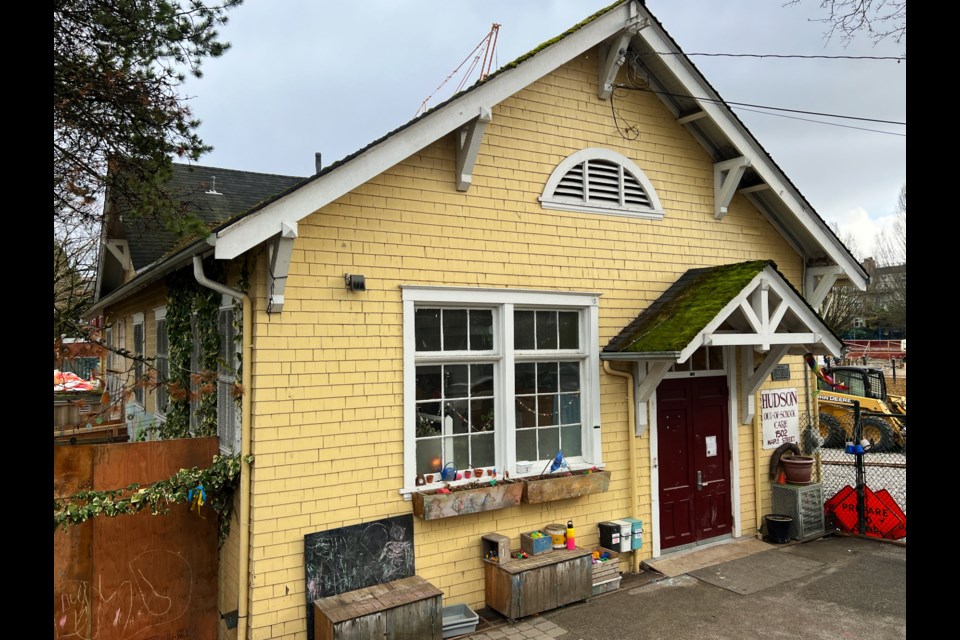The on the corner of Maple Street and Cornwall Avenue was never the flashiest building on the block.
A small, wooden structure built around 1912, it's been an auxiliary building at for the better part of a century. However, now that the school is being torn down to build a new, more seismically safe school, the yellow schoolhouse (which currently houses a childcare society) was slated to be demolished as well.
Enter Glyn Lewis and his company . Lewis only found out about the impending demolition of the schoolhouse () through happenstance.
"If we hadn't just randomly come across a Facebook comment, we would have never heard about this building," he says.
Now Lewis is in talks with the Vancouver School Board (VSB) on how to relocate the building somewhere it can be useful.
"We're working with them basically to give us permission to go find an organization or individual who will receive building and help pay for the relocation cost," he explains.
Two First Nations communities have already expressed interest in the building, notes Lewis. However, the VSB hasn't made a decision on whether to relocate or tear down the building yet.
"Following hearing from a business owner about possibly relocating the yellow schoolhouse [...] staff are reviewing the proposal to determine if it is feasible," a spokesperson for the VSB told V.I.A. by email.
Lewis is hopeful though.
"We're very pleased that they're working with us; they're doing the right thing now," he says of the VSB, noting that this process shines a light on what he says is a flaw in the system.
The flaw it raises
Lewis's company specializes in home and building relocation, and he's hoping more developers, building owners, and municipal governments will move away from demolition and towards other considerations.
Essentially he'd like people to think about houses using the old environmental mantra "Reduce, Reuse, Recycle." In this case, 'reuse' would be relocating and repurposing buildings, and 'recycling' would be the deconstruction and reuse of the building materials.
He estimates around 2,800 single-family homes are torn down in Metro Vancouver each year; another 1,000 are torn down on Vancouver Island. Of those, around 20 per cent could be relocated and repurposed; that's 760 homes per year in the province's most populous areas.
"I think there's this misconception that these old homes are of poor quality," Lewis says. "Lots are still good. They're being demolished just because they're in the wrong place."
And while Lewis agrees with the notion of densification, he believes demolishing perfectly good homes is wasteful and bad for the environment.
"The process to achieve densification is extremely wasteful," he says.
A new house has around 100 tonnes of raw material and carries tens of tonnes of carbon. Demolition sends all that to the dump.
For most developments, demolition of what is already on the land is a simple, easy solution. However, Lewis is looking for a more thoughtful triage process where more options are considered instead of jumping straight to destruction and dumping.
"The very last option should be demolition," he says.
The first option should be to see if infill is possible, though he estimates that would only work for around one per cent of properties. Next would be relocation, viable for around 20 per cent of houses.
The third consideration would be deconstruction, to salvage as much as possible from a site. Only then should demolition be considered, Lewis says.
Does it make cents?
This isn't new technology.
Relocating homes is not a new idea. Famed Vancouver resident when threatened by development and hauled it several blocks, from the foot of Gilford Street to the foot of Bidwell Street, and the other end of English Bay Beach. And the in Hastings Mill Park in Kitsilano is originally from the Gastown waterfront; it was moved in the 1930s.
Before all that, the town of Savona in B.C.'s interior was put on skids in the winter of 1884 and moved across Kamloops Lake to be close to the railway.
And Metro Vancouver already has one of the largest North American companies in building relocation in the Nickel Brothers, Lewis adds, which is the company he works with regularly.
While southern B.C.'s larger cities are looking at densification to sustainably house their populations, many smaller communities are struggling with labour shortages and material costs to build new housing stock.
"These homes are obstacles to developers in growing urban areas, but they could be a lifeline to someone who needs housing somewhere else," he says.
These days, cost-wise, Lewis says it's cheaper to relocate a house than a new build for some communities, especially islands, where labour shortages are causing costs to spike.
"You can't build on Bowen (Island) for less than $500 per square foot; to relocate this building it's going to be $80 to $100," he says of the schoolhouse.
And it's not like demolition is free; to get rid of the schoolhouse Lewis estimates it would cost the VSB around $50,000.
He's hoping government policies will be updated with green removal permits to encourage developers to use the triage model. Coquitlam is already discussing it, he says, and Seattle is working on policy as well.



